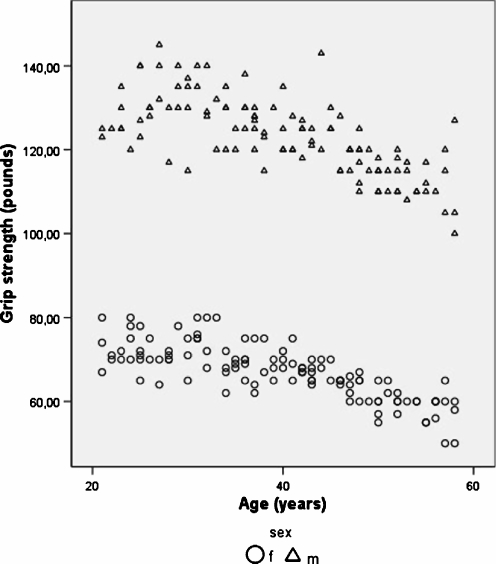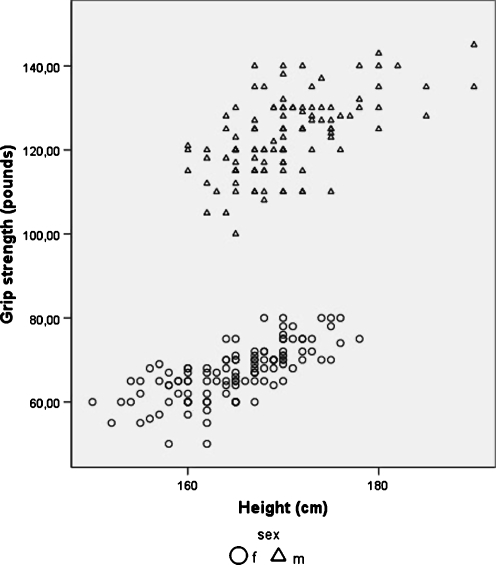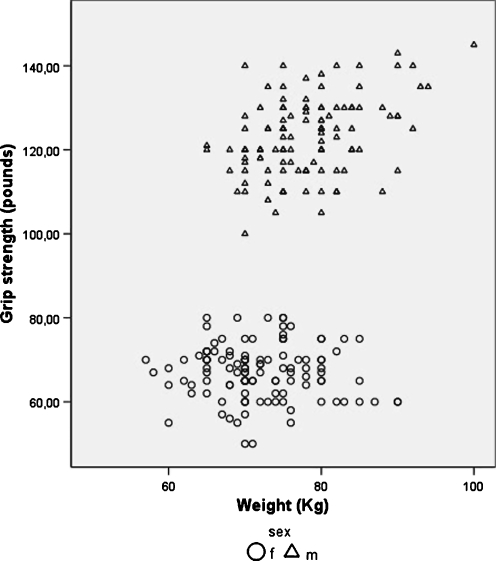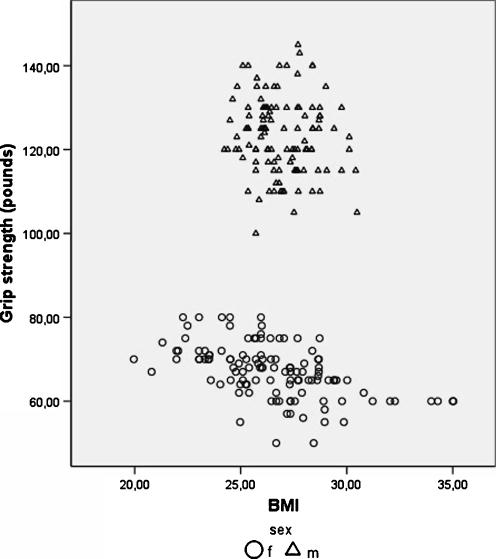Abstract
The objectives of this study were to establish data concerning normal hand grip strength (GS) and to explore possible associations with anthropometric parameters. GS was measured in 232 individuals in a standard arm position using the Jamar dynamometer. We examined differences between right/left and dominant/nondominant hands. Possible correlations of GS with anthropometric values were evaluated. Right hand and dominant hand GS were found to be higher and statistically significant compared to left hand and nondominant hand GS, respectively. Men had higher values of GS compared to women. A negative association was observed between age and dominant hand GS. A positive association was documented between height and dominant hand GS, while the respective comparison for weight and dominant hand GS documented a statistically significant positive association only in the male group. A positive association between BMI and dominant hand GS was seen in female individuals. Additional factors associated with GS should be the goal of future investigations.
Résumé
Etablir des données concernant la force de serrage de la main (GS) et, explorer les possibles associations avec des paramètres anthropométriques. La force de la main: GS a été mesurée chez 232 individus en position standard du bras, utilisant le dynamomètre de Jamar. Nous avons examiné les différences entre les côtés droit et gauche et dominant/non-dominant. Les possibles corrélations de GS avec des valeurs anthropométriques ont été évaluées. Respectivement main droite et GS du côté dominant ont été retrouvées de manière significativement plus élevée que main gauche et GS non-dominant. Les hommes avaient des valeurs de GS plus élevées que les femmes. Une association négative a été retrouvée entre l’âge et la GS de la main dominante. Une association positive a été documentée entre la taille et la GS du côté dominant, tandis que la comparaison entre le poids et la GS du côté dominant montre une association positive de manière statistiquement significative, uniquement dans le groupe des hommes. Une association positive a été retrouvée entre le BMI et la GS du côté dominant dans le groupe des femmes. Des facteurs additionnels associés avec la GS devraient être le but d’une future investigation.
Introduction
The evaluation of hand grip strength is of crucial importance in the assessment of upper limb impairment [2], in determining the effectiveness of various treatment modalities [22], and in evaluating work capacity of patients with either local hand injuries or systemic clinical entities that influence hand strength such as rheumatoid arthritis or muscular dystrophy. In particular, the establishment of norms in hand strength is both necessary and important in decision making in hand surgery to interpret evaluation data, to set realistic treatment goals, and to assess a patient’s ability to return to employment [12].
Several studies have reported normative data of hand GS from different populations using a variety of measurement methods [3, 5, 6, 8]. The Jamar dynamometer has been found to give the most accurate and acceptable measures of GS [12, 14]. The aim of this study was to establish data concerning normal hand GS in the population of north-western Greece. We studied normal hand strength, the difference between dominant and nondominant hands, and the association of parameters such as age, height, weight, and body mass index (BMI) with GS.
Materials and methods
This study included 232 individuals. The sample was randomly selected from the emergency room of the Ioannina University Hospital. All patients included in the study referred to the emergency room for traumatic conditions of the lower extremities. Exclusion criteria included the restriction of movement in the upper limbs and self-reported history of inflammatory joint disease, neurological disorder, or injury to the upper extremity. All subjects were from the Epirus region, which includes urban, suburban, and rural areas. Therefore, it was assumed that a broad range of socio-economic and occupational groups was obtained. Participants were identified in the study using a coding scheme to maintain anonymity.
Anthropometric measures were collected from each individual, and the correlation between these measures and hand GS were examined. The anthropometric measures that were obtained from each participant were weight, height, and hand dominance. Values were recorded to the nearest millimetre as part of the subject data. Other parameters such as age, sex, and occupation were also recorded.
All measurements were performed for both dominant and nondominant hands. Dominant hand was defined as the one preferred for daily activities like writing and eating and for handling heavy objects.
The standard, adjustable-handle mechanic Jamar dynamometer (FEI, Irvington, NY, USA) was used. For standardisation it was set at the second handle position for all subjects. The standard arm position for hand strength tests suggested by the American Society of Hand Therapists was used with the participant seated with the shoulder adducted and neutrally rotated, elbow flexed at 90°, and the forearm and wrist in neutral position.
Subjects performed three maximum attempts for each measurement and the highest value of these trials was recorded. It has been reported that if repeated testing is performed the best result and not the average should be recorded [5]. One-minute rests were given between each attempt. Standard instructions were used: the subjects were asked to squeeze the gauge as hard as they possibly could with the extremity in the standard position. No verbal encouragement was provided. Results were recorded to the closest pound. Calibration of the instrument was tested periodically during the study.
A t test for independent samples was used to determine whether or not there was a significant difference in the mean values. We calculated the Pearson correlation coefficient for parameters that followed a normal distribution and the nonparametric Spearman’s correlation coefficient for those with a non-normal distribution. We examined the association of age, height, weight, and BMI with GS of the dominant hand. In order to test for the association of these variables to the dominant hand GS we performed linear regression. All analyses were performed in the whole group of patients and stratified by sex. P values <0.05 were considered statistically significant; all p values were two-tailed. All statistical analyses were performed using the Statistical Package for Social Sciences (SPSS 14.0, Chicago, IL, USA).
Results
This study included 115 males and 117 females. The mean age (SD) of the participants was 39.8 years (10.5). The mean weight, height, and BMI were 75 kg (7.3), 167.6 cm (6.4), and 26.73 (2.24), respectively. The main characteristics of the population are presented in Table 1. Among the 232 individuals who participated in the study, 70 were shopkeepers (30.2%), 64 civil servants (27.6%), 37 working on domestic duties (15.9%), 27 farmers (11.6%), 19 students (8.2%), 10 workmen (4.3%), and 5 athletes (2.2%).
Table 1.
Characteristics of the population included in the study. All values are presented as mean (SD)
| Female (N = 117) | Male (N = 115) | P value* | |
|---|---|---|---|
| Age | 39.5 (10.7) | 40.1 (10.4) | 0.67 |
| Height (cm) | 165.0 (5.9) | 170.3 (5.8) | <0.001 |
| Weight (kg) | 71.9 (6.6) | 78.2 (6.6) | <0.001 |
| BMI | 26.5 (2.8) | 27.0 (1.4) | 0.12 |
| Right hand GS (lbs) | 67.1 (6.3) | 123.0 (9.2) | <0.001 |
| Left hand GS (lbs) | 60.4 (6.3) | 111.1 (9.5) | <0.001 |
| Dominant hand GS (lbs) | 67.1 (6.4) | 123.1 (9.1) | <0.001 |
| Nondominant hand GS (lbs) | 60.4 (6.2) | 111.0 (9.4) | <0.001 |
GP grip strength
* Difference between males and females
Right hand dominance was reported in 206 individuals (89%), while 26 (11%) were left hand dominant. None reported ambidexterity. The mean GS (SD) was 94.8 (29.1) lbs for the right hand and 85.5 (26.6) for the left hand. The difference was statistically significant (p < 0.001). Dominant hands had a mean strength of 94.9 (29.1) lbs, while the mean value of nondominant hands was 85.5 (26.6) lbs (p < 0.001). Left handed subjects had equal strength in both hands (p = 0.9), while in those with right hand dominance, GS was statistically significant higher in the right hand compared to the left (p < 0.001). Women had statistically significant lower values of mean GS compared to men in all measurements (p < 0.001) (Table 1).
We observed a weak negative association of age with GS of the dominant hand (Spearman’s r =−0.352, p < 0.001). This negative association was more prominent in analyses stratified by sex [Spearman’s r =−0.721, p < 0.001 in males and −0.796, p < 0.001 in females) (Fig. 1). For every year increase in age, the loss in dominant hand GS was 0.61 lbs (95% confidence interval [CI]: 0.49–0.73, p = 0.015) in men and 0.46 lbs (95% CI 0.39–0.53, p < 0.001) in women.
Fig. 1.
Scatter plot showing the negative association of age with dominant hand grip strength
We observed a moderate positive association of height with dominant hand GS (Pearson’s r =0.553, p < 0.001) (Fig. 2). In the whole study sample, for every centimetre increase in height the increase of dominant hand GS was 2.53 lbs (95% CI 2.03–3.02, p < 0.001). In males, for every centimetre increase in height the increase in dominant hand GS was 0.91 lbs (95% CI 0.67–1.15, p < 0.001), while in females the increase was 0.78 lbs (95% CI 0.64–0.92, p < 0.001) (Fig. 2).
Fig. 2.
Scatter plot showing the positive association of height with dominant hand grip strength
A weak association was observed between weight and dominant hand GS in males (Pearson’s r =0.410, p < 0.001) (Fig. 3). For every kilogram increase in weight the increase of dominant hand GS was 0.57 lbs (95% CI 0.33–0.80, p < 0.001). In females, no association was observed between weight and dominant hand GS (Pearson’s r =−0.04, p = 0.32) (Fig. 3).
Fig. 3.
Scatter plot showing a weak association between weight and dominant hand grip strength in males and no association in females
No association was observed between BMI and dominant hand GS in the total study sample (Pearson’s r = 0.018, p = 0.39) nor in male participants (Pearson’s r =−0.97, p = 0.15) (Fig. 4). In the female population, we observed a moderate negative association between BMI and dominant hand GS (Pearson’s r =−0.518, p < 0.001) (Fig. 4). For every unit increase in BMI, a loss in dominant hand GS of 1.17 lbs (95% CI 0.82–1.53, p < 0.001) was found.
Fig. 4.
Scatter plot showing no association between BMI and dominant hand grip strength in males and a moderate negative association in females
Discussion
The human hand performs various complicated and detailed operations that allow humans to complete such tasks as writing, computing, and numerous others. In an effort to explore the functional sophistication of the hand, several methods have been introduced for the development of an objective evaluating system. GS has been described as the power of the combined contraction of the extrinsic and intrinsic muscles of the hand that flex the joints of the hand.
Normative data provide a reliable method in clinical evaluation of the impact from several injuries to either the musculoskeletal or the neurological system of the hand. Moreover, normal data have a major role in assessing the effectiveness of a surgical procedure and offer a clinical approach for patient follow-up [13]. GS has been recently proposed as a predictor not only for several aetiological factors of mortality [19, 20] but also to be used for early screening of people at increased risk of physical disability in old age [18].
Many factors have been documented to be related to GS in the literature. It is generally believed that hand GS reaches a peak between the ages of 25 and 50 years [13]. Before that age there is a progressive increase of hand strength and especially GS. After the age of 50, most individuals experience a decline in their GS with increasing age, so that a curvilinear relationship between age and hand strength could be formed.
Several studies have confirmed that GS is significantly higher in men than in women in all age groups studied [1, 11]. In recent years, an improvement in GS of the female population has been documented. Considering the major change in the position of women in modern society, these changes may illustrate the growing demands in women’s occupations.
It is strongly believed that the dominant hand is 10% stronger compared to the nondominant [21]. It was reported that this difference is present in right-handed patients whereas left hand dominant patients have no statistically significant difference in GS; this was also confirmed in our study. With most hand equipment designed for right-handed people, the necessity of increased usage of their nondominant hand by the left-handed population may be a potential reason for this difference [9, 17].
Kamarul et al. [10] claims that there is a difference in GS between western and Malaysian populations. Despite the fact that there is no published study that correlates race with GS, the differences in height, weight, and physical activity across populations could explain these variations. In the same study, a significant correlation between GS with height and weight was reported. Different regression values were proposed for hand GS and height (0.29 and 0.26 for right and left hands, respectively) and for hand GS and weight (0.13 and 0.11 for right and left hands, respectively). Although height and weight were proven to be significant predictors of GS, no relationship was found between GS and BMI [4, 15]. Recently, another study investigating the association between anthropometric values with GS found that the lower ratio of the second and fourth digits’ length is related to higher mean GS only in the right hand [7].
A possible limitation of this study could be the bias of the selection of human subjects from the emergency room. Despite the fact that we included patients who referred to the emergency room for traumatic conditions of the lower extremities and we excluded those with upper limb disorders and systematic conditions that might affect grip strength, some misreporting of these disorders is inevitable.
In future studies, other factors such as prenatal androgens that seem to participate in the organising mechanism of muscular strength in men should be studied further [7]. The use of electronic dynamometers should also be considered since this might reduce limitations of the measurements performed with the hydraulic dynamometer mainly due to deviation of wrist position from the optimum one [16]. Based on the results of our study, as well as those previously published regarding normative data on hand GS, an international effort for the establishment of coefficients for GS evaluation should be the future target. These coefficients should incorporate anthropometric parameters such as sex, weight, height, and BMI in order to evaluate the optimal normal GS for the postoperative or the posttraumatic hand based on hand dominance and on GS of the contra-lateral side.
References
- 1.Agnew PJ, Maas F. Hand function related to age and sex. Arch Phys Med Rehabil. 1982;63:269–271. [PubMed] [Google Scholar]
- 2.Blair SJ, McCormick E, Bear-Lehman J, Fess EE, Rader E. Evaluation of impairment of the upper extremity. Clin Orthop Relat Res. 1987;221:42–58. [PubMed] [Google Scholar]
- 3.Boatright JR, Kiebzak GM, O’Neil DM, Peindl RD. Measurement of thumb abduction strength: normative data and a comparison with grip and pinch strength. J Hand Surg [Am] 1997;22:843–848. doi: 10.1016/S0363-5023(97)80079-2. [DOI] [PubMed] [Google Scholar]
- 4.Cauley JA, Petrini AM, LaPorte RE, Sandler RB, Bayles CM, Robertson RJ, Slemenda CW. The decline of grip strength in the menopause: relationship to physical activity, estrogen use and anthropometric factors. J Chronic Dis. 1987;40:115–120. doi: 10.1016/0021-9681(87)90062-2. [DOI] [PubMed] [Google Scholar]
- 5.Crosby CA, Wehbé MA, Mawr B. Hand strength: normative values. J Hand Surg [Am] 1994;19:665–670. doi: 10.1016/0363-5023(94)90280-1. [DOI] [PubMed] [Google Scholar]
- 6.Desrosiers J, Bravo G, Hebert R, Dutil E. Normative data for grip strength of elderly men and women. Am J Occup Ther. 1995;49:637–644. doi: 10.5014/ajot.49.7.637. [DOI] [PubMed] [Google Scholar]
- 7.Fink B, Thanzami V, Seydel H, Manning JT. Digit ratio and hand-grip strength in German and Mizos men: cross-cultural evidence for an organizing effect of prenatal testosterone on strength. Am J Hum Biol. 2006;18:776–782. doi: 10.1002/ajhb.20549. [DOI] [PubMed] [Google Scholar]
- 8.Hager-Ross C, Rosblad B. Norms for grip strength in children aged 4–16 years. Acta Paediatr. 2002;91:617–625. doi: 10.1080/080352502760068990. [DOI] [PubMed] [Google Scholar]
- 9.Incel NA, Ceceli E, Durukan PB, Erdem HR, Yorgancioglu ZR. Grip strength: effect of hand dominance. Singap Med J. 2002;43:234–237. [PubMed] [Google Scholar]
- 10.Kamarul T, Ahmad TS, Loh WY. Hand grip strength in the adult Malaysian population. J Orthop Surg (Hong Kong) 2006;14:172–177. doi: 10.1177/230949900601400213. [DOI] [PubMed] [Google Scholar]
- 11.Kellor M, Frost J, Silberberg N, Iversen I, Cummings R. Hand strength and dexterity. Am J Occup Ther. 1971;25:77–83. [PubMed] [Google Scholar]
- 12.Mathiowetz V, Weber K, Volland G, Kashman N. Reliability and validity of grip and pinch strength evaluations. J Hand Surg [Am] 1984;9:222–226. doi: 10.1016/s0363-5023(84)80146-x. [DOI] [PubMed] [Google Scholar]
- 13.Mathiowetz V, Kashman N, Volland G, Weber K, Dowe M, Rogers S (1985) Grip and pinch strength: normative data for adults. Arch Phys Med Rehabil 66:69–74 [PubMed]
- 14.Mathiowetz V. Comparison of Rolyan and Jamar dynamometers for measuring grip strength. Occup Ther Int. 2002;9:201–209. doi: 10.1002/oti.165. [DOI] [PubMed] [Google Scholar]
- 15.Niempoog S, Siripakarn Y, Suntharapa T. An estimation of grip strength during puberty. J Med Assoc Thail. 2007;90:699–705. [PubMed] [Google Scholar]
- 16.O’Driscoll SW, Horii E, Ness R, Cahalan TD, Richards RR, An KN. The relationship between wrist position, grasp size, and grip strength. J Hand Surg [Am] 1992;17:169–177. doi: 10.1016/0363-5023(92)90136-D. [DOI] [PubMed] [Google Scholar]
- 17.Petersen P, Petrick M, Connor H, Conklin H. Grip strength and hand dominance: challenging the 10% rule. Am J Occup Ther. 1989;43:444–447. doi: 10.5014/ajot.43.7.444. [DOI] [PubMed] [Google Scholar]
- 18.Rantanen T, Guralnik JM, Foley D, Masaki K, Leveille S, Curb JD, White L. Midlife hand grip strength as a predictor of old age disability. JAMA. 1999;281:558–560. doi: 10.1001/jama.281.6.558. [DOI] [PubMed] [Google Scholar]
- 19.Rantanen T, Volpato S, Ferrucci L, Heikkinen E, Fried LP, Guralnik JM. Handgrip strength and cause-specific and total mortality in older disabled women: exploring the mechanism. J Am Geriatr Soc. 2003;51:636–641. doi: 10.1034/j.1600-0579.2003.00207.x. [DOI] [PubMed] [Google Scholar]
- 20.Sasaki H, Kasagi F, Yamada M, Fujita S. Grip strength predicts cause-specific mortality in middle-aged and elderly persons. Am J Med. 2007;120:337–342. doi: 10.1016/j.amjmed.2006.04.018. [DOI] [PubMed] [Google Scholar]
- 21.Schmidt RT, Toews JV. Grip strength as measured by the Jamar dynamometer. Arch Phys Med Rehabil. 1970;51:321–327. [PubMed] [Google Scholar]
- 22.Toth S. Therapist’s management of tendon transfers. Hand Clin. 1986;2:239–246. [PubMed] [Google Scholar]






